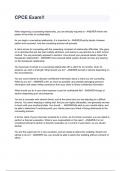Essay
Unit 21 LA: A&B (Ionising techniques and non - ionising techniques)
- Course
- Institution
In overall, this unit has achieved DISTINCTION grade and contains all of the necessary contents. This assignment consists of two assignments as A&B assignment is merged together as the distinction criteria is required to compare the ionising techniques from LA:A and non ionising techniques from LA:...
[Show more]












